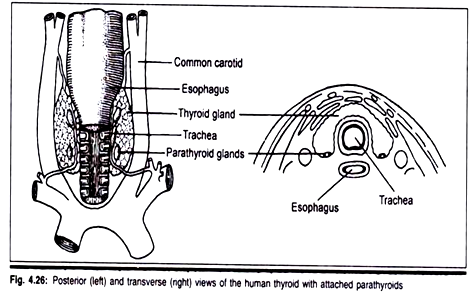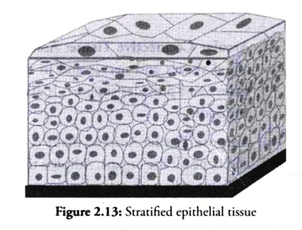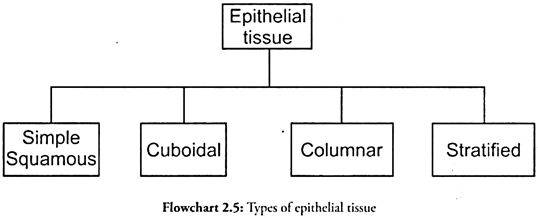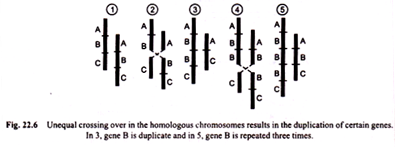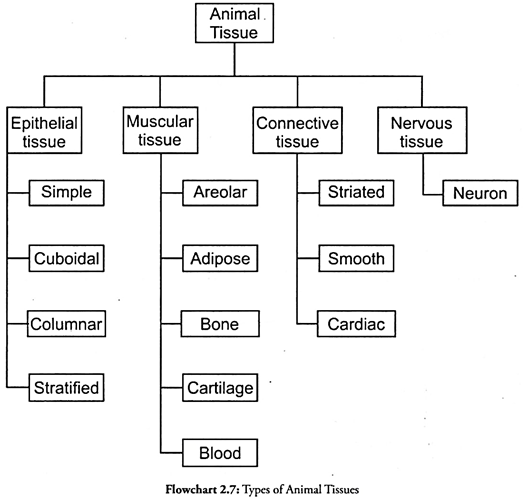ADVERTISEMENTS:
Here is a term paper to learn about:- 1. Introduction to Tissues 2. Tissues in a Plant 3. Tissues in an Animal.
Term Paper # 1. Introduction to Tissues:
Organisms are either unicellular or multicellular. Accordingly the functions are performed either by a single cell or by a group of cells. Cells, tissues, organs and organ systems split up the work in a way that exhibits division of labor and contribute to the survival of the body as a whole. This work division ensures proper specific defined function of the body.
In unicellular organisms like bacteria, all the functions like digestion, respiration and reproduction are performed by a single cell. In the complex body of multicellular animals, the same basic functions are carried out by groups of cells in a well-organized manner. The body of a simple organism like Hydra is composed of different types and the number of cells. The human body is composed of billions of cells to perform various functions. In multicellular animals, a group of similar cells along with intercellular substances perform a specific function. Such an organization is called as tissue.
ADVERTISEMENTS:
Tissues vary according to their origin and function, and are different in plants and animals.
Term Paper # 2. Tissues in a Plant:
Plant tissues can also be divided differently into two types on basis of their division ability:
1. Meristematic tissues
2. Permanent tissues.
ADVERTISEMENTS:
1. Meristematic Tissue:
Meristematic tissue consists of actively dividing cells, leading to increase in length and thickness of the plant. The primary growth of a plant occurs only in certain, specific regions, such as in the tips of stems or roots. It is in these regions that meristematic tissue is present. Meristematic tissues are classified on the basis of their location.
They are of the following types:
(a) Apical Meristem:
Apical meristem is present on the stem apex, root apex, flower buds and leaf buds. They are actively dividing cells that require proper nutrition and energy for the division and hence are green in color to carry out photosynthesis. They are responsible for growth in length, i.e. primary growth.
(b) Lateral Meristem:
Lateral meristems are found along the side of the stem. It consists of cells which mainly divide in one plane and cause the organ to increase in diameter and growth. Lateral Meristem usually occurs beneath the bark of a tree in the form of cork cambium and in vascular bundles of dicots in the form of vascular cambium. They are responsible for growth in girth or width, i.e. secondary growth.
(c) Intercalary Meristem:
Intercalary meristem is present at the base of a leaf or internodes. They are present on the either sides of the node.
2. Permanent Tissue:
ADVERTISEMENTS:
When the cells of a meristematic tissue divide to a certain extent, they become specialized for a particular function. This process is called as the differentiation. After differentiation, the cells lose their capability to divide and is differentiated to their capability to perform various functions of the organism. The tissue becomes permanent tissue after differentiation.
Permanent tissues are of two types:
a. The simple permanent tissue and
b. The complex permanent tissue.
ADVERTISEMENTS:
a. Simple Permanent Tissue:
These tissues are called simple because they are composed of similar types of cells which have common origin and function.
Simple permanent tissues are of three types, viz.
(i) Parenchyma,
ADVERTISEMENTS:
(ii) Collenchyma and
(iii) Sclerenchyma.
(i) Parenchyma:
The cells of parenchyma have thin cell wall. They are loosely packed; with a lot of intercellular spaces between them. Parenchyma consists of the largest portion of a plant body. The main function of parenchyma is to provide support and to store food. In aquatic plants, large air cavities are present in parenchyma.
Some parenchyma contain chlorophyll and perform photosynthesis, in this case it is called a chlorenchyma. Parenchyma with large air cavities provide buoyancy to the plant, then the parenchyma is known as aerenchyma.
(ii) Collenchyma:
ADVERTISEMENTS:
Collenchymatous tissue acts as a supporting tissue in the stems of young plants. It provides mechanical support, elasticity, and tensile strength to the plant body. It helps in manufacturing sugar and storing it as starch.
It is present in the margin of leaves and resists tearing effect of the wind. Cells are elongated with thick primary walls thickened with cellulose and no intercellular spaces. Cells that have chloroplasts perform photosynthesis.
(iii) Sclerenchyma:
The cell wall is very thick with lignin which is a water proof material. The cells are dead and intercellular space is absent. The nucleus is absent. It provides a structural rigidity to the plant parts. Examples of sclerenchyma are bark, coconut husk.
They are fibers present in a vascular tissue to transport water or sclereids found in the cortex, pith, phloem for strength and firmness. These cells are involved in a mechanical support and protection for seeds.
b. Complex Permanent Tissue:
The complex tissue consists of more than one type of cells which work together as a unit. Complex tissues help in the transportation of organic material, water and mineral up and down the plants. That is why it is also known as conducting and vascular tissue.
Complex permanent tissues are of two types, viz.
(i) Xylem and
(ii) Phloem.
Xylem and phloem together make the vascular bundle in plants.
(i) Xylem:
Xylem consists of:
a. Tracheid
b. Vessel members
c. Xylem fibers
d. Xylem parenchyma.
Xylem is a chief, conducting tissue of the vascular plants. It conducts water and mineral ions. The cells of xylem are dead; except the cells of xylem parenchyma. Tracheid and vessels are tubular structures and thus they provide a channel for conduction of the water and minerals. Xylem fiber provides structural support to the tissue. Xylem parenchyma stores the food.
(ii) Phloem:
Phloem consists of:
a. Sieve tube
b. Sieve cell
c. Companion cell
d. Phloem fibre
e. Phloem parenchyma.
Sieve tubes are tubular cells with perforated walls. Sieve tubes are the conducting elements of phloem. Phloem is responsible for the translocation of food in the plants. The transport of food in phloem is both upward and downward movement.
Term Paper # 3. Tissues in an Animal:
There are four types animal tissues:
1. Epithelial tissue,
2. Connective tissue,
3. Muscular tissue and
4. Nervous tissue.
1. Epithelial Tissue:
The epithelial tissue forms a covering or lining of most of the organs. The cells of epithelial tissue are tightly packed and form a continuous sheet. There is a small amount of cementing materials between the cells and there is no intercellular space.
Due to the absence of blood vessel supply to the epithelium, its permeability plays an important role in the exchange of materials among various organs. It also plays an important role in osmoregulation. All epithelial tissues are separated by the underlying tissue by an extracellular fibrous basement membrane.
Epithelial tissues are of the following types:
(a) Simple Epithelium:
The simple epithelium is composed of a single layer of cells. This type of epithelial tissue forms the lining of blood vessels and alveoli facilitating exchange of gases and fluids.
(b) Cuboidal Epithelium:
These cells are cube-shaped, provide a mechanical support. Linings of kidney tubules and ducts of salivary glands are composed of cuboidal epithelium. Cells of epithelium may play the role of secretion and then they are called glandular epithelium. It helps in secretion, excretion and absorption of materials from the food or blood.
(c) Columnar Epithelium:
These cells are column-shaped that facilitates secretion and absorption.
Example:
The lining of the intestine is composed of columnar epithelium. In some organs, columnar epithelium has cilia present on the outer surface which facilitate movements of certain substances. The ciliated epithelium in the respiratory tract pushes the mucus forward produced in the goblet cells.
(d) Stratified Epithelium:
Cells of the stratified epithelium are in many layers. Basal layer is in contact with the basement membrane and newer cells occupy the upper layers. Skin is an example of stratified epithelium. Stratification of layers prevents wear and tear. This is highly water proof and resistant to mechanical injury.
2. Connective Tissue:
The cells of a connective tissue are loosely scattered in a matrix secreted by its cells. The matrix can be a fluid, jelly like, dense or rigid. The nature of the matrix depends on the function, which a connective tissue serves. It helps in binding bones and cartilages, packing, supporting structures of the body.
Following are the various connective tissues:
A. Connective tissue proper- matrix is jelly, less rigid.
B. Skeletal tissue- matrix is solid.
C. Vascular tissue- matrix is fluid.
A. Connective Tissue Proper:
i. Loose connective tissue proper- It has less fiber and more matrix.
ii. Dense connective tissue proper- It has more fiber and less matrix.
i. Loose Connective Tissue Proper:
(a) Areolar Connective Tissue:
Areolar tissue is found between the skin and muscles, around the blood vessels and nerves and in the bone marrow. Areolar tissue fills up the gap between the tissues and provides support. It also helps in repairing the tissues, as packing material, produces antibodies.
(b) Adipose Tissue:
Adipose tissue is composed of fat globules. This tissue is found below the skin and beneath the organs. Adipose tissue provides an insulation and works as a cushion. Adipocytes are large cells with soft jelly like matrix and less fibers.
ii. Dense Connective Tissue Proper:
(a) Tendon:
It is a tough non fibrous dense tissue. It is white in colour with great strength and less flexibility. It joins skeletal muscle to the bone for contraction.
(b) Ligament:
It is a dense yellow fibrous tissue with strength and elasticity that binds bones together for bending.
B. Skeletal Tissue:
(a) Bone:
The bone is mainly composed of osteoblasts. The bone makes the skeletal system. The skeletal system is responsible for providing a structural framework to the body. It provides protection to important organs and facilitates movements. It has a fluid in it that is called as the bone marrow. The matrix is concentric rings made up of collagenous protein.
(b) Cartilage:
The cartilage is mainly composed of chondrioblasts. The cartilage is present at the ends of the articulatory bones. Cartilage is also present in external ear, bronchi, etc. a non- porous tissue filled with a fluid called lacunae. The major function of the cartilage is support and flexibility.
C. Vascular Tissue:
(a) Blood:
The blood is composed of blood cells, platelets and plasma. The blood plays an important role in the transportation of various substances in the body. It also helps in osmoregulation and temperature control, transportation of oxygen and nutrients.
(b) Lymph:
It is a light yellow colored fluid made up of plasma and WBC. It helps in exchange of materials between blood and tissue fluid.
3. Muscular Tissue:
Muscular tissue is composed of the muscle cells. The muscle cells are specialized cells that have the capability to contract and expand. Due to the contraction and expansion, the muscles facilitate various kinds of movements in the body.
Muscular tissues are of three types:
(a) Striated Muscles:
The cells of striated muscles are in the form of a long, un-branched fibers. The cells are multinucleate. Light and dark bands (striations) are present on the muscle fibers; which gives the name striated muscles. Striated muscles are found in the organs where a voluntary movement is possible, e.g. hands, legs, back, neck, etc.
(b) Smooth Muscles:
The cells of the smooth muscles are spindle shaped and each has one nucleus. The smooth muscle is found in the organs where an involuntary movement is possible, e.g. alimentary canal.
(c) Cardiac Muscles:
The cells of cardiac muscles are in the form of branched fibers. In these muscles, striations are present and cells are uninucleate. These are found in the heart. The cardiac muscles are capable of continuous contraction and relaxation throughout the life.
4. Nervous Tissue:
The nervous system is made up of a nervous tissue. The nervous tissue is composed of specialized cells called neuron.
A neuron can be divided into two distinct parts, viz.:
a. Head and
b. Tail.
a. Head:
The head is somewhat star-shaped and contains nucleus and some other cell organelles. This is called as cyton. There are numerous hair-like outgrowths coming out of the cyton. These are called as dendrites.
b. Tail:
The tail ends in axon terminals. The dendrites receive the nerve impulse, while axon relays the nerve signals.














